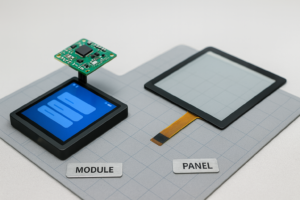Did you ever think about how touch screen is revolutionizing industries like manufacturing and healthcare? Touch screens are ubiquitous, but the one for your application is difficult to find.
Whether it’s durability for harsh environments, precision for medical devices, or specialization for unique tasks, the right touch screen can make a huge impact.
So, in this article, we will discuss the newest developments and applications of touch screens, revealing how they’re helping industries become smarter and more productive. So, let’s find out how bespoke touch screens can help overcome your issues!
The Evolution of Touch Screen Technology
Before moving straight to innovations and applications of touch screens in modern-day industries, it’s better to know its history first.
The Early Days: 1960s–1970s
So, it all started in the 1960s with the first experiments. A touch screen was created at Bell Telephone Labs in 1960 by using a grid of lights to detect input. By 1965, Eric Johnson had come up with a touchscreen that was finger-operated, hence more user-friendly.
During the 1970s, the initial resistive touch screen was developed by Dr. Samuel Hurst in 1971, but it wasn’t transparent until 1974. Around the same time, CERN engineers developed the first transparent capacitive touch panels, which served as the foundation of the touchscreens we have today.
The Rise of Multi-Touch: 1980s–1990s
The 1980s saw the arrival of multi-touch technology. In 1982, University of Toronto researchers created a system that was able to sense multiple touches with a frosted-glass panel and a camera.
In the 1990s, touchscreens started appearing in consumer devices. IBM’s Simon, launched in 1993, was the first resistive touch screen smartphone, setting the stage for future smartphones.
The Smartphone Revolution: 2000s–Present
The 2000s were the game-changer. LG’s KE850 Prada, released in 2006, was the first phone to feature capacitive touch panels. But it was Apple’s iPhone in 2007 that truly changed the game with its multi-touch screen.
Today, touchscreens are everywhere—in phones, tablets, industrial devices, and medical devices. New technologies like AI, borderless designs, waterproof displays, and energy-efficient displays keep pushing touch screen technology.
From humble beginnings to the high-tech systems we see today, touchscreens have transformed how we interact with technology, and they are still evolving.
Now let’s understand the application of touchscreens in industries and the medical sector.
Industrial Touchscreens Applications
In industrial settings, touchscreens are transforming operations with their rugged, user-friendly interfaces. Some of the most significant applications of industrial touchscreens are:
- Automation Systems: High-brightness screens readily connect with Programmable Logic Controllers (PLCs) for efficient machine monitoring and control. This boosts productivity and reduces downtime.
- Transportation and Logistics: Fleet management systems make use of embedded touch solutions to monitor vehicles, track cargo, and plan routes efficiently. Warehouse management systems also make use of touchscreens for real-time inventory tracking.
- Energy and Utilities: Touchscreens at power plants and smart grids allow operators to track the generation and distribution of energy, ensuring reliability and efficiency.
Medical Applications of Touch Screens
The healthcare industry has embraced touchscreen technology to improve patient care and streamline operations. Key applications include:
- Patient Monitoring Systems: Touchscreens enable medical staff to view critical patient data, such as temperature and heart rate, in a timely manner, allowing for prompt interventions.
- Medical Equipment Control: Machines like X-ray machines and dialysis machines are equipped with touchscreens to facilitate easy operation, enhancing diagnostic accuracy and treatment efficiency.
- Telemedicine: 5G-enabled capacitive touch panels offer remote consultations, allowing physicians to retrieve patient records and diagnostic images in real time.
Innovations Shaping the Future of Touch Screens
The future of touchscreen technology is being shaped by groundbreaking innovations that will transform the way we interact with devices.
From the integration of AI to adaptive designs, these are the key trends driving the future of touchscreens in 2025 and beyond.
1. AI-Powered Touchscreens
Artificial intelligence is also making touchscreens more intelligent and intuitive. AI analyzes user behavior, predicts their needs, and streamlines interactions to create more personalized and efficient experiences.
For example, AI-powered retail kiosks suggest products to consumers based on their interests, while meeting systems generate summaries in real time to improve productivity.
2. Enhanced Durability and Hygiene
There is a growing demand for durable and hygienic touchscreens. Features like antibacterial coating, water-resistant materials, and high-temperature resistance offer durability in extreme environments.
For instance, antibacterial glass on self-service medical terminals improves safety, and waterproof displays kiosks in foodservice perform flawlessly in humid environments.
3. Borderless and Freeform Designs
Ultra-thin bezels and bezel-less designs are becoming the norm, offering sleek aesthetics and immersive experiences. Curved, transparent, and flexible touchscreens are enabling new application opportunities.
For example, transparent high-brightness screens in shops allow shoppers to read product details while looking at the real products behind the screen.
4. Energy Efficiency
Low-power touchscreens are gaining popularity, reducing operational costs, and aligning with sustainability initiatives. Micro-LED and E-Ink are a few of the technologies enabling this.
For example, low-power touchscreens at bus stops deliver real-time transit information while cutting energy usage by over 30%.
5. 5G and IoT Integration
5G and the Internet of Things (IoT) are combining to enable real-time interactivity. Capacitive touch panels now connect seamlessly to other systems and the cloud, making user experiences more streamlined.
For instance, 5G-enabled interactive restaurant tables allow diners to order food and watch live kitchen video feeds, enhancing the dining experience.
6. Flexible and Foldable Displays
Flexible touchscreens made from materials like OLED are making foldable wearables and smartphones a reality. These embedded touch solutions are durable and flexible, offering portability without the compromise of screen size.
7. Advanced Touch Sensing
Technologies like SigmaSense’s ShareTouch™ and Who Touch are revolutionizing touch interactions. ShareTouch™ enables secure data transfer with just a touch, and Who Touch identifies users to deliver personalized experiences.
These technologies are enhancing collaboration, gaming, and healthcare applications.
8. Holographic Displays
Holographic touchscreens are bringing 3D images to life, with immersive experiences for gaming and learning. Imagine characters leaping off the screen or interactive holograms bringing learning experiences to life.
From smarter interfaces to flexible designs, these innovations are shaping the future of touchscreens, making them more versatile, efficient, and intuitive. As technology continues to evolve, touchscreens will remain at the forefront of digital development across industries.
Custom Touch Screen Solutions
Customization is key to meeting the individual needs of diverse industries. So, there are companies like Interelectronix and New Vision Display that specialize in creating custom touchscreen solutions.
These include:
- Ruggedized Screens: These touchscreens are built to handle extreme environments and are best suited for outdoor and industrial touchscreens applications.
- Medical-Grade Displays: Built to meet stringent healthcare demands, these displays are resistant to fluids, scratches, and high-frequency interference.
- Embedded Touch Solutions: Touchscreens can be embedded within existing hardware to create a more integrated solution, enhancing functionality and usability.
Conclusion
In conclusion, touchscreens drive technological innovation, boost efficiency, and improve user experiences across industries. Their applications span from industrial touchscreens automation to healthcare and waterproof displays are expanding.
By embracing the latest trends and customizing solutions to suit specific needs, businesses can stay ahead in the competitive touchscreen business.
Whether you’re shopping for rugged industrial touchscreens displays, high-brightness screens or high-performance medical-grade displays, the future of touch technology is full of endless possibilities.
.png)



